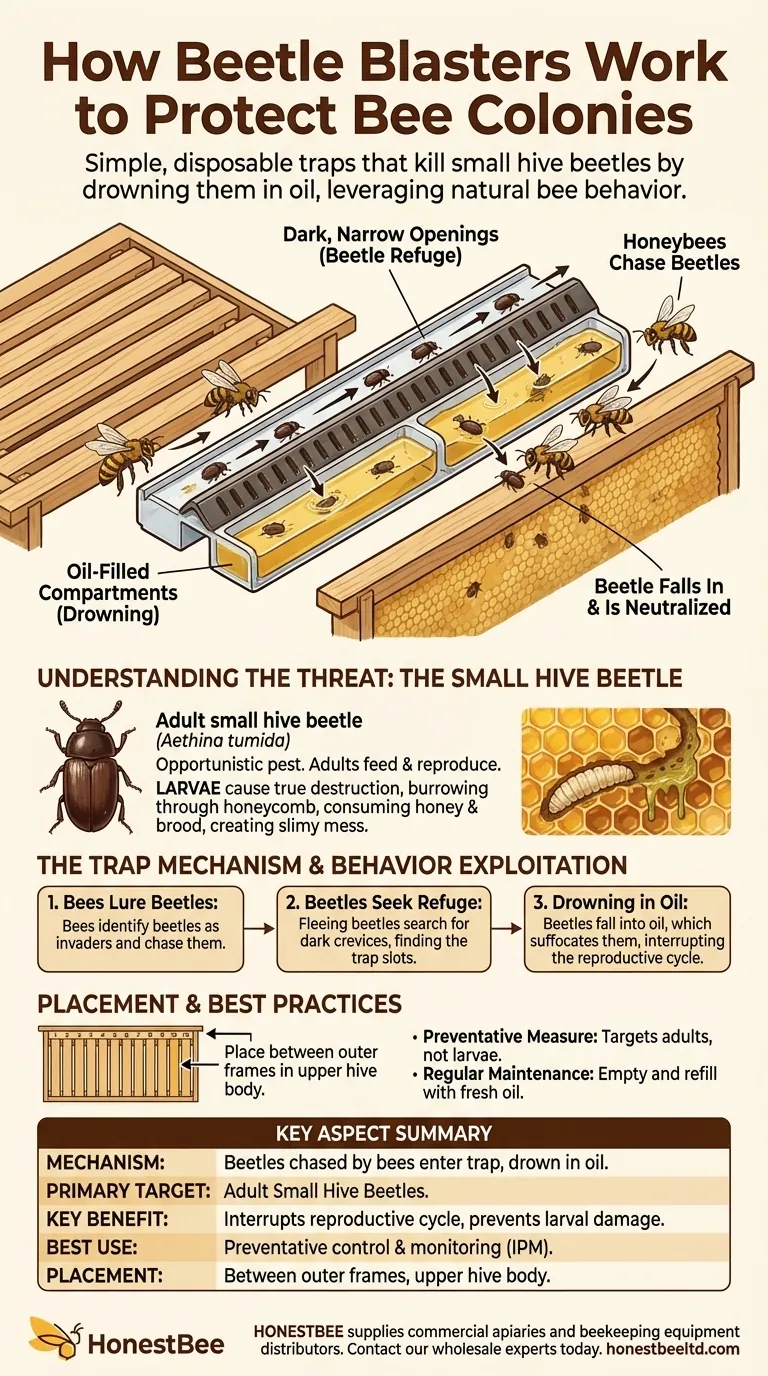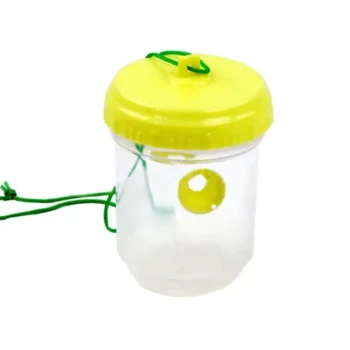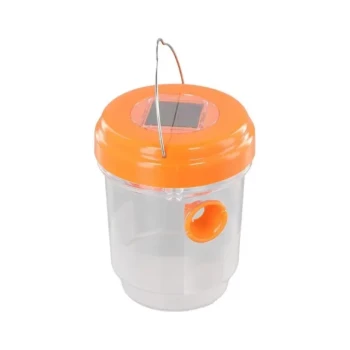In short, beetle blasters are simple, disposable traps that kill small hive beetles by drowning them in oil. Placed between the frames of a beehive, they exploit the natural behavior of both bees and beetles. Honeybees chase the invasive beetles, driving them to seek refuge in the dark, narrow openings of the blaster, where they fall into the oil-filled compartments and are neutralized.
The core principle behind beetle blasters is not just to kill beetles, but to leverage the bees' own defensive behaviors. The trap acts as a deadly extension of the bees' efforts, efficiently removing adult beetles from the hive before they can reproduce and overwhelm the colony.

Understanding the Threat: The Small Hive Beetle
To appreciate how a beetle blaster works, you must first understand the pest it targets. The small hive beetle (Aethina tumida) is an opportunistic pest that can devastate a honeybee colony, particularly one that is already weak.
The Beetle's Life Cycle and Behavior
Adult beetles enter a hive to feed on pollen and honey, but their primary goal is to reproduce. They seek out cracks and crevices to lay their eggs, hidden from the bees.
Bees will attempt to corral the adult beetles, imprisoning them in "jails" made of propolis. However, a strong beetle population can easily overwhelm the bees' capacity to manage them.
The Real Damage: Beetle Larvae
The true destruction is not caused by the adult beetles, but by their larvae. Once beetle eggs hatch, the larvae burrow through the honeycomb, consuming honey, pollen, and bee brood.
As they feed, they defecate in the honey, causing it to ferment and run out of the cells. This creates a characteristic slimy, foul-smelling mess that can ruin the entire hive, often forcing the bee colony to abscond (abandon the hive completely).
How Beetle Blasters Exploit Beetle Behavior
Beetle blasters are designed to turn the beetle's own survival instincts against it. The trap's design is simple but highly effective.
Using the Bees as a Lure
The primary "lure" for a beetle blaster is the honeybee itself. Worker bees instinctively identify beetles as invaders and aggressively chase them across the frames.
The Trap Mechanism
Fleeing from the bees, the beetles search for a dark, safe place to hide. The slots on the top of a beetle blaster mimic the small crevices beetles naturally seek.
When a beetle crawls into the trap to escape its pursuers, it falls into one of two reservoirs filled with a non-toxic substance, typically mineral oil or vegetable oil. The oil coats the beetle, quickly suffocating it.
The Goal: Population Control
By trapping and killing adult beetles, you interrupt their reproductive cycle. Every adult caught is one less beetle laying eggs, preventing the catastrophic larval infestation from ever starting.
Understanding the Trade-offs and Best Practices
While effective, beetle blasters are a tool, not a complete solution. Proper use is critical for success.
They Target Adults, Not Larvae
Beetle blasters are a preventative measure. They are extremely effective at controlling the adult beetle population but do nothing to address a hive that is already overrun with larvae.
Placement is Critical
For maximum effectiveness, blasters should be placed in the upper hive body between the outer frames (e.g., between frames 1 and 2, and 9 and 10 in a 10-frame box). This is where beetles often congregate to escape the main bee cluster.
Regular Maintenance is Required
The traps must be checked and maintained. Over time, they will fill with beetles and debris. They should be carefully removed, emptied, and refilled with fresh oil to remain effective. Spilling oil in the hive can harm bees and contaminate honey.
Applying This to Your Hive Management
Beetle blasters are a key component of an Integrated Pest Management (IPM) strategy for your apiary.
- If your primary focus is protecting a new or weak colony: Use beetle blasters immediately to prevent the hive from becoming overwhelmed while it builds its population.
- If your primary focus is maintaining a strong, established colony: Use blasters as a monitoring tool and a proactive control measure to keep beetle numbers low and reduce stress on your bees.
- If your primary focus is dealing with an existing larval infestation: Recognize that beetle blasters are not enough; you must take more drastic steps, such as removing slimed frames and potentially reducing the hive's internal space.
Ultimately, using beetle blasters empowers you to support your bees' natural defenses, creating a healthier and more resilient colony.
Summary Table:
| Key Aspect | How Beetle Blasters Work |
|---|---|
| Mechanism | Beetles chased by bees enter trap slots and drown in oil-filled reservoirs. |
| Primary Target | Adult small hive beetles (Aethina tumida). |
| Key Benefit | Interrupts beetle reproductive cycle, preventing larval damage. |
| Best Use | Preventative control and monitoring within an Integrated Pest Management (IPM) strategy. |
| Placement | Between outer frames in the upper hive body. |
Protect Your Investment with Professional-Grade Beekeeping Supplies
Are beetle blasters a key part of your hive management strategy? Ensure your apiary is equipped with the most effective tools. HONESTBEE supplies commercial apiaries and beekeeping equipment distributors with the durable, reliable supplies needed for successful, large-scale operations.
Let us help you build a more resilient and productive apiary. Contact our wholesale experts today to discuss your needs and our full product catalog.
Visual Guide

Related Products
- Removable Washable Hive Beetle Trap Attractants for Small Hive Beetles
- Reusable Aluminium Beetle Trap for Small Hive Beetles Silver Bullet
- Plastic Beetle Blaster Trap Beekeeping Tools and Supplies
- Reusable Clear Small Hive Beetle Traps for Beehives Beetle Trapping Tools
- Black Plastic Beetle Barn Hive Beetle Trap for Beehives
People Also Ask
- What is the recommended number of beetle traps per hive? Optimize Your Hive's Beetle Defense
- What should be done if a hive shows signs of a small hive beetle infestation? Protect Your Hive Now
- What are small hive beetles and where are they not indigenous? Protect Your Apiary from This Invasive Pest
- How do Beetle Blasters trap adult beetles? A Simple, Non-Chemical Pest Control Solution
- What are the steps for installing hive beetle traps? A Guide to Effective Beetle Control



















